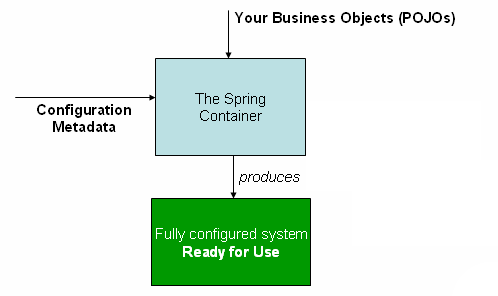Spring Boot Dependency Injection(IoC)
What is IoC or dependency injection?
IoC is also known as dependency injection (DI). It is a process whereby objects define their dependencies (that is, the other objects they work with) only through constructor arguments, arguments to a factory method, or properties that are set on the object instance after it is constructed or returned from a factory method.
The container then injects those dependencies when it creates the bean. This process is fundamentally the inverse (hence the name, Inversion of Control) of the bean itself controlling the instantiation or location of its dependencies by using direct construction of classes or a mechanism such as the Service Locator pattern.
Container Overview
The org.springframework.context.ApplicationContext interface represents the Spring IoC container and is responsible for instantiating, configuring, and assembling the beans.
The container gets its instructions on what objects to instantiate, configure, and assemble by reading configuration metadata. The configuration metadata is represented in XML, Java annotations, or Java code. It lets you express the objects that compose your application and the rich interdependencies between those objects.
The following diagram shows a high-level view of how Spring works. Your application classes are combined with configuration metadata so that, after the ApplicationContext is created and initialized, you have a fully configured and executable system or application.

In stand-alone applications, it is common to create an instance of ClassPathXmlApplicationContext or FileSystemXmlApplicationContext. In a web application, you can add a simple web.xml for XML-based configuration or use @Configuration for Java-based configuration.
XML-based configuration
// create and configure beans
ApplicationContext context = new ClassPathXmlApplicationContext("services.xml", "daos.xml");
// retrieve configured instance
PetStoreService service = context.getBean("petStore", PetStoreService.class);
// use configured instance
List<String> userList = service.getUsernameList();
The configuration metadata represents how you, as an application developer, tell the Spring container to instantiate, configure, and assemble the objects in your application.
There are 3 ways now to implement configuration metadata: XML based configuration, Java-based configuration, annotation-based configuration.
These days, developers prefer to use Java-based configuration for their projects.
Spring configuration consists of at least one and typically more than one bean definition that the container must manage. XML-based configuration metadata configures these beans as <bean/> elements inside a top-level <beans/> element. Java configuration typically uses @Bean-annotated methods within a @Configuration class.
The convention is to use the standard Java convention for instance field names when naming beans. That is, bean names start with a lowercase letter and are camel-cased from there. Examples of such names include accountManager,accountService, userDao, loginController, and so forth.
Naming beans consistently makes your configuration easier to read and understand. Also, if you use Spring AOP, it helps a lot when applying advice to a set of beans related by name.
Circular dependencies exist, when one or more collaborating beans are being injected into a dependent bean, each collaborating bean is totally configured prior to being injected into the dependent bean. This means that, if bean A has a dependency on bean B, the Spring IoC container completely configures bean B prior to invoking the setter method on bean A.
@DependsOn – The depends-on attribute can explicitly force one or more beans to be initialized before the bean using this element is initialized.
By default, Spring eagerly instantiates all beans in the container when it starts up. But if needed you can lazy instantiate such beans so that they are created when they are first requested. However, when a lazy-initialized bean is a dependency of a singleton bean that is not lazy-initialized, Spring creates the lazy-initialized bean at startup, because it must satisfy the singleton’s dependencies. The lazy-initialized bean is injected into a singleton bean elsewhere that is not lazy-initialized.
